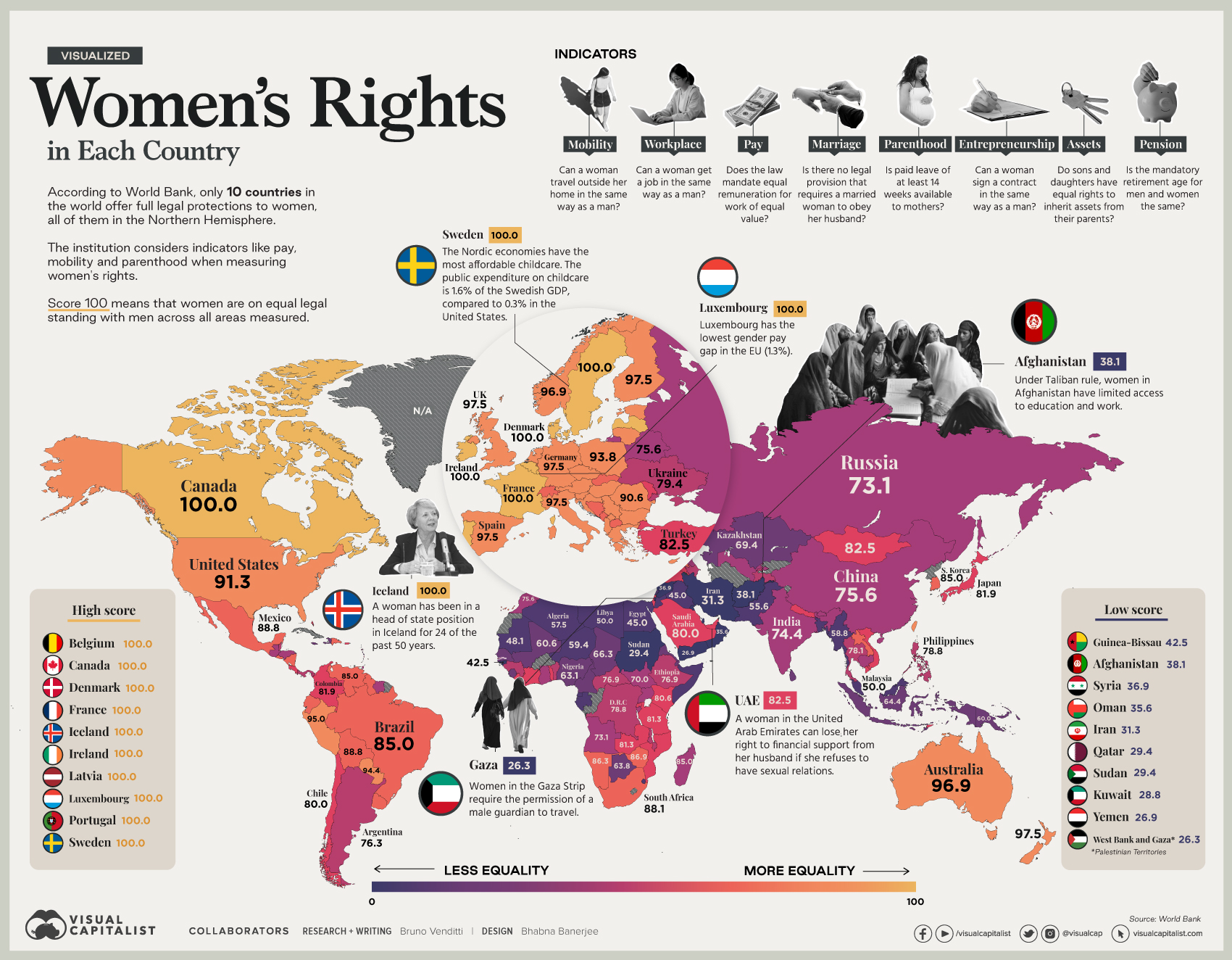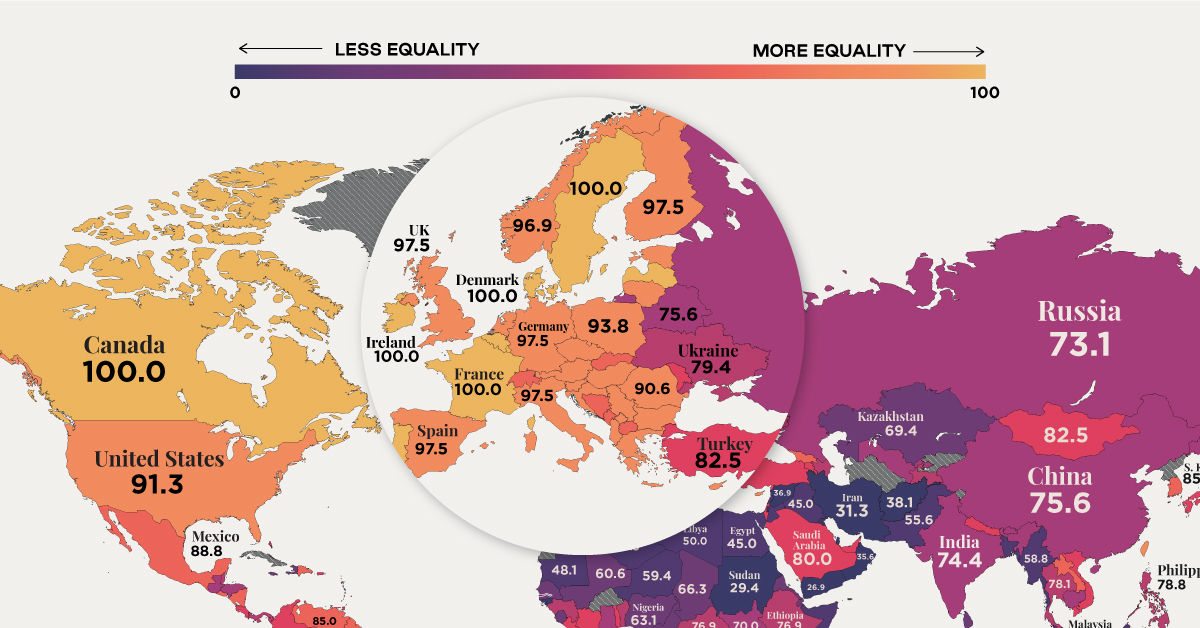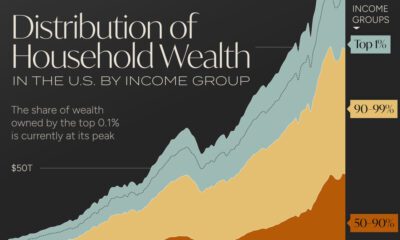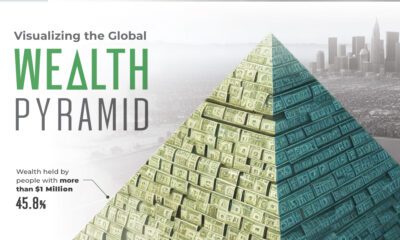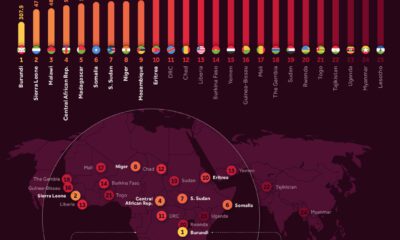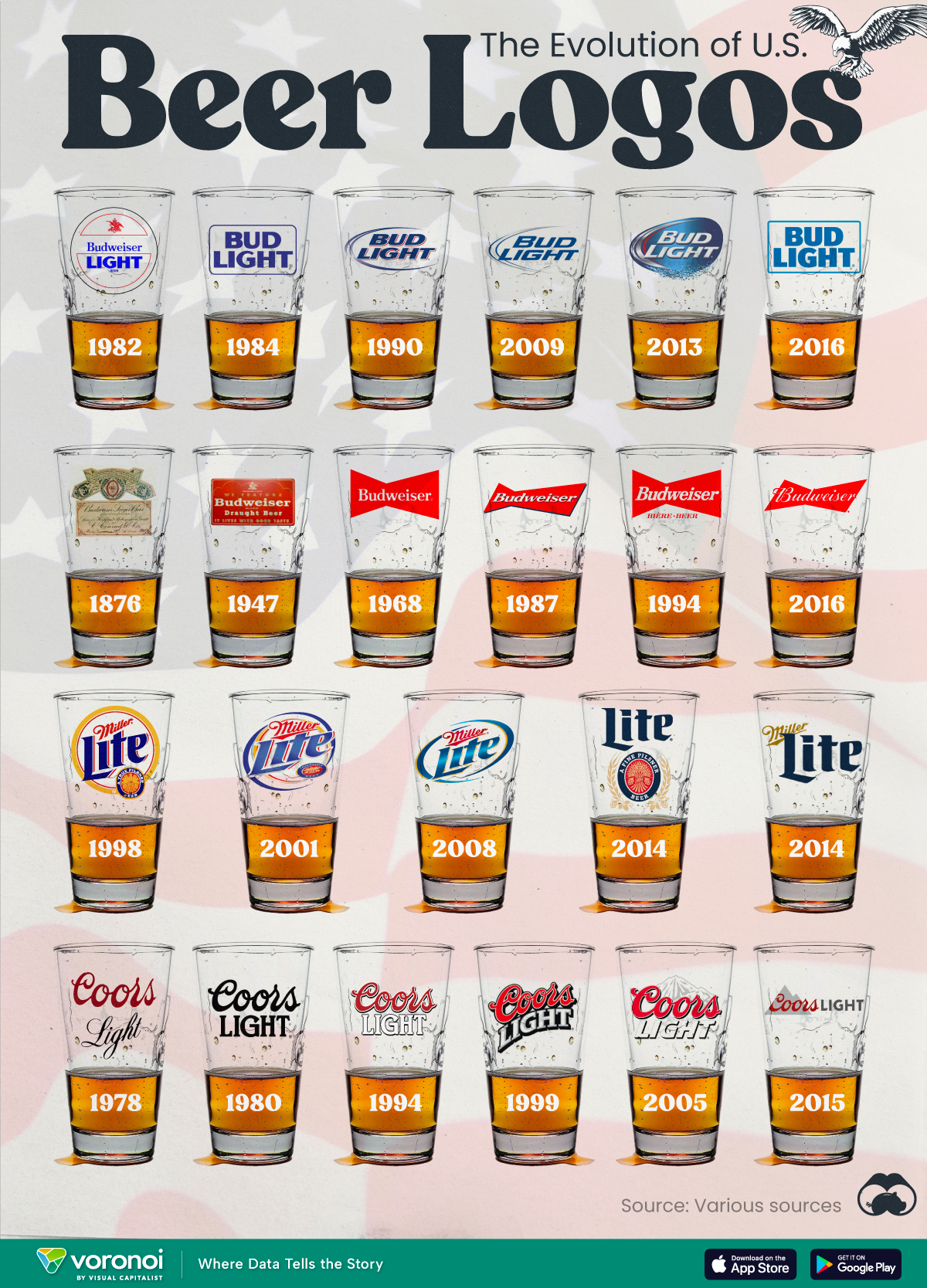Misc
Visualizing Women’s Economic Rights Around the World
Visualizing Women’s Economic Rights in Each Country
In recent years, many economies have made women’s rights a priority by eliminating job restrictions, working to reduce the gender wage gap, or changing legislation related to marriage and parenthood.
Still, many laws continue to inhibit women’s ability to enter the workforce or start a business—and even to travel outside their homes in the same way as men. In fact, on average globally, women have just three-quarters of the economic rights of men.
This map uses data from the Women, Business and Law 2021 report by the World Bank, to visualize women’s economic rights around the world.
Legal Protections
According to the World Bank, only 10 countries offer full legal protections to women, and all of them are in the Northern Hemisphere.
In ranking countries, the institution considers indicators like equal remuneration, legal rights, and mobility. A score of 100 means that women are on equal legal standing with men across all areas measured.
| Rank | Country/Territory | Score |
|---|---|---|
| 1 | Belgium | 100.0 |
| 1 | Canada | 100.0 |
| 1 | Denmark | 100.0 |
| 1 | France | 100.0 |
| 1 | Iceland | 100.0 |
| 1 | Ireland | 100.0 |
| 1 | Latvia | 100.0 |
| 1 | Luxembourg | 100.0 |
| 1 | Portugal | 100.0 |
| 1 | Sweden | 100.0 |
| 2 | Estonia | 97.5 |
| 2 | Finland | 97.5 |
| 2 | Germany | 97.5 |
| 2 | Greece | 97.5 |
| 2 | Italy | 97.5 |
| 2 | Netherlands | 97.5 |
| 2 | New Zealand | 97.5 |
| 2 | Spain | 97.5 |
| 2 | United Kingdom | 97.5 |
| 3 | Australia | 96.9 |
| 3 | Austria | 96.9 |
| 3 | Hungary | 96.9 |
| 3 | Norway | 96.9 |
| 3 | Slovenia | 96.9 |
| 4 | Peru | 95.0 |
| 5 | Paraguay | 94.4 |
| 6 | Croatia | 93.8 |
| 6 | Czech Republic | 93.8 |
| 6 | Lithuania | 93.8 |
| 6 | Poland | 93.8 |
| 6 | Serbia | 93.8 |
| 7 | Kosovo | 91.9 |
| 7 | Mauritius | 91.9 |
| 8 | Albania | 91.3 |
| 8 | Cyprus | 91.3 |
| 8 | Taiwan, China | 91.3 |
| 8 | United States | 91.3 |
| 9 | Bulgaria | 90.6 |
| 9 | Romania | 90.6 |
| 10 | Ecuador | 89.4 |
| 10 | Hong Kong, China | 89.4 |
| 11 | Bolivia | 88.8 |
| 11 | El Salvador | 88.8 |
| 11 | Malta | 88.8 |
| 11 | Mexico | 88.8 |
| 11 | Uruguay | 88.8 |
| 12 | Lao PDR | 88.1 |
| 12 | Montenegro | 88.1 |
| 12 | South Africa | 88.1 |
| 13 | Guyana | 86.9 |
| 13 | Zimbabwe | 86.9 |
| 14 | Cabo Verde | 86.3 |
| 14 | Dominican Republic | 86.3 |
| 14 | Namibia | 86.3 |
| 14 | Nicaragua | 86.3 |
| 14 | São Tomé and Príncipe | 86.3 |
| 15 | Georgia | 85.6 |
| 15 | Switzerland | 85.6 |
| 16 | Bosnia and Herzegovina | 85.0 |
| 16 | Brazil | 85.0 |
| 16 | Korea, Rep. | 85.0 |
| 16 | North Macedonia | 85.0 |
| 16 | Slovak Republic | 85.0 |
| 16 | Venezuela | 85.0 |
| 17 | Moldova | 84.4 |
| 17 | Togo | 84.4 |
| 18 | Liberia | 83.8 |
| 18 | Puerto Rico (US) | 83.8 |
| 18 | St. Lucia | 83.8 |
| 19 | Costa Rica | 83.1 |
| 19 | Côte d'Ivoire | 83.1 |
| 19 | Timor-Leste | 83.1 |
| 20 | Armenia | 82.5 |
| 20 | Fiji | 82.5 |
| 20 | Mongolia | 82.5 |
| 20 | Mozambique | 82.5 |
| 20 | Singapore | 82.5 |
| 20 | Turkey | 82.5 |
| 20 | United Arab Emirates | 82.5 |
| 21 | Colombia | 81.9 |
| 21 | Japan | 81.9 |
| 21 | Vietnam | 81.9 |
| 22 | Bahamas | 81.3 |
| 22 | Tanzania | 81.3 |
| 22 | Zambia | 81.3 |
| 23 | Grenada | 80.6 |
| 23 | Israel | 80.6 |
| 23 | Kenya | 80.6 |
| 23 | Nepal | 80.6 |
| 23 | Rwanda | 80.6 |
| 24 | Chile | 80.0 |
| 24 | Samoa | 80.0 |
| 24 | San Marino | 80.0 |
| 24 | Saudi Arabia | 80.0 |
| 25 | Belize | 79.4 |
| 25 | Burkina Faso | 79.4 |
| 25 | Panama | 79.4 |
| 25 | Ukraine | 79.4 |
| 26 | Azerbaijan | 78.8 |
| 26 | Congo, Dem. Rep. | 78.8 |
| 26 | Kiribati | 78.8 |
| 26 | Philippines | 78.8 |
| 26 | Tajikistan | 78.8 |
| 27 | Lesotho | 78.1 |
| 27 | Thailand | 78.1 |
| 28 | Benin | 77.5 |
| 28 | Malawi | 77.5 |
| 29 | Barbados | 76.9 |
| 29 | Central African Republic | 76.9 |
| 29 | Ethiopia | 76.9 |
| 29 | Kyrgyz Republic | 76.9 |
| 30 | Argentina | 76.3 |
| 30 | Guinea | 76.3 |
| 30 | Seychelles | 76.3 |
| 31 | Belarus | 75.6 |
| 31 | China | 75.6 |
| 31 | Morocco | 75.6 |
| 32 | Cambodia | 75.0 |
| 32 | Ghana | 75.0 |
| 32 | Honduras | 75.0 |
| 32 | Trinidad and Tobago | 75.0 |
| 33 | Gambia | 74.4 |
| 33 | India | 74.4 |
| 33 | Madagascar | 74.4 |
| 34 | Maldives | 73.8 |
| 34 | Suriname | 73.8 |
| 35 | Angola | 73.1 |
| 35 | Burundi | 73.1 |
| 35 | Russia | 73.1 |
| 35 | Uganda | 73.1 |
| 36 | Bhutan | 71.9 |
| 37 | St. Kitts and Nevis | 71.3 |
| 38 | Guatemala | 70.6 |
| 38 | Uzbekistan | 70.6 |
| 39 | South Sudan | 70.0 |
| 40 | Eritrea | 69.4 |
| 40 | Kazakhstan | 69.4 |
| 40 | Sierra Leone | 69.4 |
| 41 | Dijibouti | 68.1 |
| 41 | Jamaica | 68.1 |
| 41 | Marshall Islands | 68.1 |
| 41 | St. Vicent and the Grenadines | 68.1 |
| 42 | Tunisia | 67.5 |
| 43 | Senegal | 66.9 |
| 44 | Antigua and Barbuda | 66.3 |
| 44 | Chad | 66.3 |
| 45 | Sri Lanka | 65.6 |
| 46 | Comoros | 65.0 |
| 47 | Indonesia | 64.4 |
| 48 | Botswana | 63.8 |
| 48 | Haiti | 63.8 |
| 48 | Micronesia | 63.8 |
| 49 | Nigeria | 63.1 |
| 50 | Dominica | 62.5 |
| 51 | Mali | 60.6 |
| 52 | Cameroon | 60.0 |
| 52 | Papua New Guinea | 60.0 |
| 53 | Niger | 59.4 |
| 54 | Myanmar | 58.8 |
| 54 | Palau | 58.8 |
| 54 | Tonga | 58.8 |
| 55 | Vanuatu | 58.1 |
| 56 | Algeria | 57.5 |
| 56 | Gabon | 57.5 |
| 57 | Solomon Islands | 56.9 |
| 58 | Bahrain | 55.6 |
| 58 | Pakistan | 55.6 |
| 59 | Brunei Darussalam | 53.1 |
| 60 | Lebanon | 52.5 |
| 61 | Equatorial Guinea | 51.9 |
| 62 | Libya | 50.0 |
| 62 | Malaysia | 50.0 |
| 63 | Bangladesh | 49.4 |
| 63 | Congo, Rep. | 49.4 |
| 64 | Mauritania | 48.1 |
| 65 | Jordan | 46.9 |
| 65 | Somalia | 46.9 |
| 66 | Eswatini | 46.3 |
| 67 | Egypt | 45.0 |
| 67 | Iraq | 45.0 |
| 68 | Guinea-Bissau | 42.5 |
| 69 | Afghanistan | 38.1 |
| 70 | Syria | 36.9 |
| 71 | Oman | 35.6 |
| 72 | Iran | 31.3 |
| 73 | Qatar | 29.4 |
| 73 | Sudan | 29.4 |
| 74 | Kuwait | 28.8 |
| 75 | Yemen | 26.9 |
| 76 | West Bank and Gaza | 26.3 |
According to the report, there are 20 economies in the world where women still have half or fewer of the legal economic rights of men.
Under Taliban rule, for example, women in Afghanistan have limited access to education and work. In the Gaza Strip, women must have the permission of a male guardian to travel.
Yet, some differences are also seen in developed countries.
In the U.S, women still earn an average of about 82 cents for each dollar earned by men, and the gap across many countries in Europe is similar. Meanwhile, women are represented in just 23% of seats in national parliaments globally, and make up just 13% of agricultural landholders.
The Shadow Pandemic
COVID-19 has exacerbated existing inequalities that disadvantage girls and women, including barriers to attend school and maintain jobs, according to the United Nations.
In fact, new research shows that the sectors that have been most affected by the pandemic so far are those with high levels of women workers, including the restaurant and hospitality business, as well as the travel sector.
While leaders debate recovery in a post-pandemic world, rights equality remains a central topic for social and economic development.
Misc
The Evolution of U.S. Beer Logos
In this graphic, we analyze the evolution of popular U.S. beer logos like Budweiser, Coors Light, Bud Light, and more.
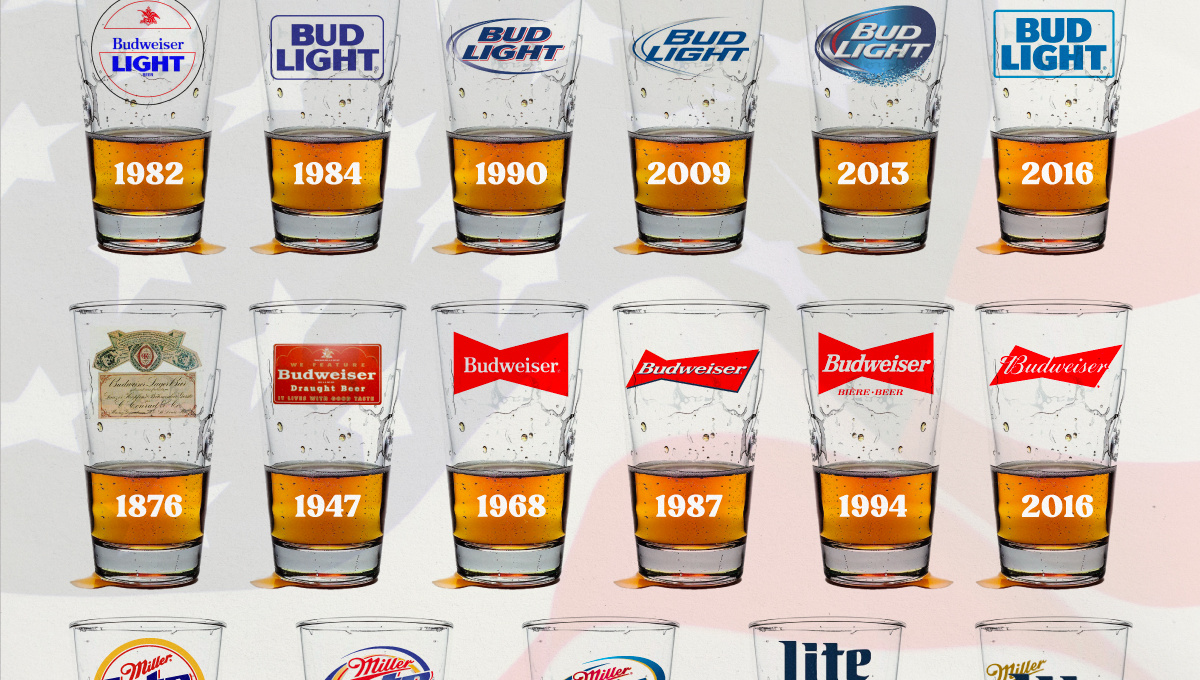
The Evolution of U.S. Beer Logos
This was originally posted on our Voronoi app. Download the app for free on iOS or Android and discover incredible data-driven charts from a variety of trusted sources.
Despite selling a popular product, beer companies have to be creative to stand out in a competitive market.
In this graphic, we analyze the evolution of some U.S. beer logos based on various sources. We chose brands based on a mixture of criteria, including popularity (based on YouGov surveys), availability of logo assets, and those with interesting developments.
Bud Light Back to the ’80s
Despite recent backlash and calls for a boycott after sending a commemorative can to transgender influencer Dylan Mulvaney, Bud Light remains one of America’s best-selling beers.
The brand of light beer, owned by the Anheuser-Busch company, has switched from its more circular logo with italic letters adopted in the 1990s back to the Bud Light badge of the 1980s. It is composed of heavy uppercase lettering, written in two levels in a shade of blue with the inscription placed on a solid white background and enclosed in a thin rectangular frame.
Miller Lite Goes Old School
After following a similar approach to Bud Light’s branding throughout the 2000s, Miller Lite decided to undergo a major rebranding in 2014.
The company returned to its 1970s roots, once again combining a white can with its original blue, gold, and red logo. The redesign was largely considered a success, given that Miller Lite sales immediately increased following the change.
A Symbol of American Brewing
The oldest brand on our U.S. beer list, the Budweiser logo, has undergone more than 15 changes over the years.
The design of two connected triangles represents a red bow tie, as a symbol of American brewing.
The colors of the Budweiser logo include a vibrant red, which helps the logo stand out and be easily recognizable from a distance. Studies also suggest that the color red stimulates appetite. Meanwhile, the white inscription symbolizes purity and cleanliness.
Curious to learn more about the beer market? Check out this graphic about global beer consumption.
-

 Economy6 days ago
Economy6 days agoRanked: The Top 20 Countries in Debt to China
-

 Demographics2 weeks ago
Demographics2 weeks agoThe Countries That Have Become Sadder Since 2010
-

 Money2 weeks ago
Money2 weeks agoCharted: Who Has Savings in This Economy?
-

 Technology2 weeks ago
Technology2 weeks agoVisualizing AI Patents by Country
-

 Markets2 weeks ago
Markets2 weeks agoEconomic Growth Forecasts for G7 and BRICS Countries in 2024
-

 Wealth2 weeks ago
Wealth2 weeks agoCharted: Which City Has the Most Billionaires in 2024?
-

 Technology1 week ago
Technology1 week agoAll of the Grants Given by the U.S. CHIPS Act
-

 Green1 week ago
Green1 week agoThe Carbon Footprint of Major Travel Methods

